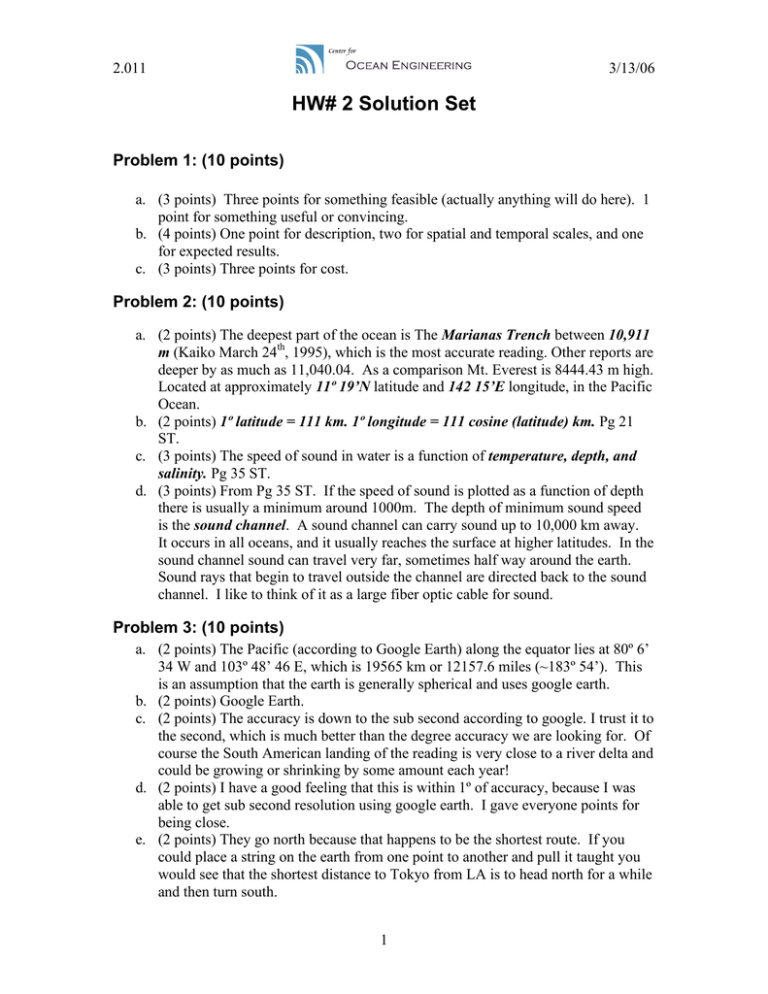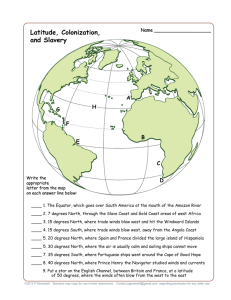HW# 2 Solution Set Problem 1: (10 points)
advertisement

2.011 3/13/06 HW# 2 Solution Set Problem 1: (10 points) a. (3 points) Three points for something feasible (actually anything will do here). 1 point for something useful or convincing. b. (4 points) One point for description, two for spatial and temporal scales, and one for expected results. c. (3 points) Three points for cost. Problem 2: (10 points) a. (2 points) The deepest part of the ocean is The Marianas Trench between 10,911 m (Kaiko March 24th, 1995), which is the most accurate reading. Other reports are deeper by as much as 11,040.04. As a comparison Mt. Everest is 8444.43 m high. Located at approximately 11º 19’N latitude and 142 15’E longitude, in the Pacific Ocean. b. (2 points) 1º latitude = 111 km. 1º longitude = 111 cosine (latitude) km. Pg 21 ST. c. (3 points) The speed of sound in water is a function of temperature, depth, and salinity. Pg 35 ST. d. (3 points) From Pg 35 ST. If the speed of sound is plotted as a function of depth there is usually a minimum around 1000m. The depth of minimum sound speed is the sound channel. A sound channel can carry sound up to 10,000 km away. It occurs in all oceans, and it usually reaches the surface at higher latitudes. In the sound channel sound can travel very far, sometimes half way around the earth. Sound rays that begin to travel outside the channel are directed back to the sound channel. I like to think of it as a large fiber optic cable for sound. Problem 3: (10 points) a. (2 points) The Pacific (according to Google Earth) along the equator lies at 80º 6’ 34 W and 103º 48’ 46 E, which is 19565 km or 12157.6 miles (~183º 54’). This is an assumption that the earth is generally spherical and uses google earth. b. (2 points) Google Earth. c. (2 points) The accuracy is down to the sub second according to google. I trust it to the second, which is much better than the degree accuracy we are looking for. Of course the South American landing of the reading is very close to a river delta and could be growing or shrinking by some amount each year! d. (2 points) I have a good feeling that this is within 1º of accuracy, because I was able to get sub second resolution using google earth. I gave everyone points for being close. e. (2 points) They go north because that happens to be the shortest route. If you could place a string on the earth from one point to another and pull it taught you would see that the shortest distance to Tokyo from LA is to head north for a while and then turn south. 1 2.011 3/13/06 Problem 4: (10 points) a. (2 points) The sky is blue because the atmosphere scatters shorter frequency wavelengths (ie blue, violet), but lets wavelengths that are longer (reds, oranges, yellows) through with little or no scattering. (Wikipedia) b. (2 points) The sky near the horizon is much thicker than above. Therefore, in the daytime the light near the horizon tends to be paler than above. In the evening as the sunsets the sunlight appears even redder because the remaining wavelengths (longer) are filtered even further, thus filtering almost all the blues and greens leaving a very orange or red Sun. The scattering effect is known as Rayleigh law. (Wikipedia) c. (2 points) C=λ*f (wave speed = wavelength * frequency) d. (2 points) Blue light = 430-500 nm, Green light = 520-565 nm, Red light = 625740 nm. e. (2 points) Blue light (~430nm) propagates furthest in water because it is the least absorbed. Problem 5: (10 points) a. (5 points) The direction of the winds is from the high-pressure zone to the lowpressure zones. The 30ºN and 30º S high-pressure regions blow towards the equator. The equatorial region tends to blow towards the west because of the converging winds from the north and south. Pg. 41 ST. b. (5 points) The highest evaporation occurs around the 30ºN and 30ºS latitudes. The equatorial region has heavy precipitation. Pg. 41 ST. Problem 6: (10 points) a. (4 points) In general, the warmest surface temperatures are found at the equator ~30º C. The heat gradually dissipates to ~23ºC near the 30ºN and 30ºS longitude lines. Near the poles have the coldest surface temperatures -1ºC. The moderate temperatures (23ºC – 10ºC) occur between 30ºN and ~55ºN in the north and 30ºS to 55ºS. The rest of the water is cold toward the poles and varies from 10ºC to 1ºC. There are irregularities to this trend. In the Pacific along the equator near Equador has colder water below 23ºC and extends from the coast ~10º longitude. The Pacific coast of South America and the Atlantic coast of Africa are 10º colder than the rest of the ocean at that latitude. There is also a 10º cooler region along the pacific coast of America and Atlantic coast Europe. Together these regions narrow the warm surface temperatures region found at the higher latitudes. The western Pacific is warmer on average than the eastern portion. The Indian ocean is dominated by 30ºC temperatures. b. (4 points) The main cause of the ocean surface temperature is the sun. The sun heats the water through isolation. The ocean releases heat in the form of radiation. The average temperature of the sea relates to the intensity of the sunlight at that region. The sun reaches the earth most directly at the equator with decreasing angles of incidence at the increasing latitudes. In general, this assumption is valid. The irregularities are due to wind driven currents and separately from deep waters coming to the surface. For instance, along the equator the winds are typically westerly. This causes the warm waters along the Western coast of the Americas to move eastward. To replace the movement of 2 2.011 3/13/06 those warm waters the cooler waters from higher latitudes move into those regions. They are of course heated but the cooler regions causes the narrowing of the warm band along both the western coast of the Americas and the western coast of Africa and Europe. The strange cold surface temperature off the coast of Equador may be explained as some upwelling of a cooler water from the deeper sea. c. (4 points) The simplest model is to say that the water temperature is linear decline of 30ºC at 0º latitude to 24ºC at 30ºN and 30ºS. Then taking another linear fit from 24ºC at 30ºN and 30ºS to -1º at 90ºN and 90ºS. This is a very crude model but in general works against the data. In general the sun affects the surface temperature directly, which can vary if winds and currents are strong enough or persistent enough throughout the year. If you proposed a model that seemed reasonable I gave you full points. If you actually came up with an equation you get kudos. Problem 7: (10 points) Full points for mentioning your interests in this course. 3






